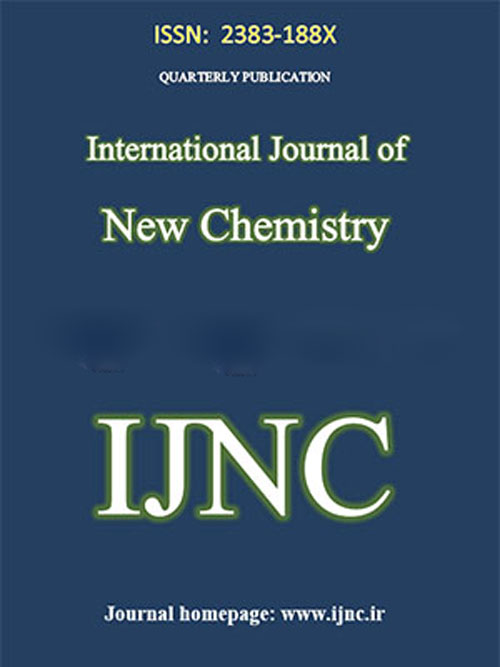فهرست مطالب

International Journal of new Chemistry
Volume:1 Issue: 2, Summer 2014
- تاریخ انتشار: 1393/06/30
- تعداد عناوین: 5
-
Pages 51-59Electrical sensitivity of a boron nitride nanotube (BNNT) was examined toward ethyl acetylene (C4H6) molecule by using density functional theory (DFT) calculations at the B3LYP/6-31G (d) level, and it was found that the adsorption energy (Ead) of ethyl acetylene the pristine nanotubes is about -1.60kcal/mol. But when nanotube has been doped with Si and Al atoms, the adsorption energy of ethylacetylene molecule was increased. Calculation showed that when the nanotube is doping by Al, the adsorption energy is about -24.19kcal/mol and also the amount of HOMO/LUMO energy gap (Eg) will reduce significantly. Boron nitride nanotube is a suitable adsorbent for ethylacetylene and can be used in separation processes ethylacetylene. It is seem that nanotube (BNNT) is a suitable semiconductor after doping, and the doped BNNT in the presence of ethylacetylene an electrical signal is generating directly and therefore can potentially be used as ethylacetylene sensors.Keywords: Sensor, Nanotube, DFT, Ethyl acetylene
-
Pages 60-67The reactive 1:1 intermediate produced in the reaction between cyclohexyl isocyanide and electron- deficient acetylenic esters or dimethyl acetylene dicarboxylate was trapped by 2-cyano-N-(Aryl) acetamides to provides highly functionalized oxopyridine (potential synthetic and pharmaceutical interest ) in acetonitrile under mild reaction conditions at ambient temperature after 24 h in fairly good yields. The structures of the products were corroborated spectroscopically (IR, 1H- and 13C-NMR), by EI - MS, and elemental analysis. A possible mechanism for this reaction is proposed. This present method carries the advantage that not only is the reaction performed under neutral conditions, but also the substances and reagents can be mixed without any modification or activation. The simplicity of this procedure and use of simple starting materialsmakes it an interesting alternative to other approaches.Keywords: multicomponent reactions, cyanoacetamides, zwitterions, oxopyridine
-
Pages 68-76Electrical sensitivity of a boron nitride nanotube (BNNT) was examined toward pyrrole (C5H6N) molecule by using density functional theory (DFT) calculations at the B3LYP/6-31G (d) level, and it was found that the adsorption energy (Ead) of pyrrole on the pristine nanotubes is a bout -16.37kcal/mol. But when nanotube have been doped with Si and Al atomes, the adsorption energy of pyrrole molecule was increased. Calculation showed that when the nanotube is doping by Si, the adsorption energy is about -24.29kcal/mol and also the amount of HOMO/LUMO energy gap (Eg) will reduce significantly. It seems that nanotube (BNNT) is a suitable semiconductor after doping, and the doped BNNT in the presence of pyrrole an electrical signal is generating directly and therefore can potentially be used for pyrrole sensors, and BNNT is a suitable adsorbent for pyrrole molecules.Keywords: Sensor, Nanotube, DFT, Pyrrole
-
Pages 77-84Electrical sensitivity of a beryllium oxide nanotube (BeONT) was examined toward (C5H5N) molecule by using density functional theory (DFT) calculations at the B3LYP/6-31(d) level, and it was found that the adsorption energy (Ead) of pyridine on the pristine nanotubes is a bout -73.29kcal/mol. But when nanotubes has been doped with S and P atomes , the adsorption energy changed . Calculation showed that when the nanotube is doping by P, the adsorption energy is about -39.59kcal/mol and also the amount of HOMO/LUMO energy gap (Eg) will reduce significantly (Eg=2.55Ev). The BeONT doped with P is suitable semiconductor than the pristine BeONT.Keywords: Nanotube, DFT, Pyridine
-
Pages 85-96Systematic studies on the substituent effect in para substituted Fe(CO)4pyridine complexes have been studied on the basis of DFT quantum-chemical calculations. The following substituents were taken into consideration: NO2, CN, CHO, F, H, CH3, and OH. Additionally, the FeN and FeC bonds were characterized on the basis of Atoms in Molecules topological analysis of electron density. It has been found that the substituents in position 4 of the pyridine ring influence the FeN bond of Fe(CO)4pyridine complex in a systematic manner, as a result of with, the pyridine moiety has a diversified ability of participating in the interaction with the Fe atom of Fe(CO)4 moiety. It has also been found, that the electron withdrawing substituents additionally stabilize the FeN bond, whereas the electron donating ones weaken it. The substituent effect mainly affects the component of the FeN bond.Keywords: complexes, Fe–N bond, DFT, Fe(CO) –pyridine


